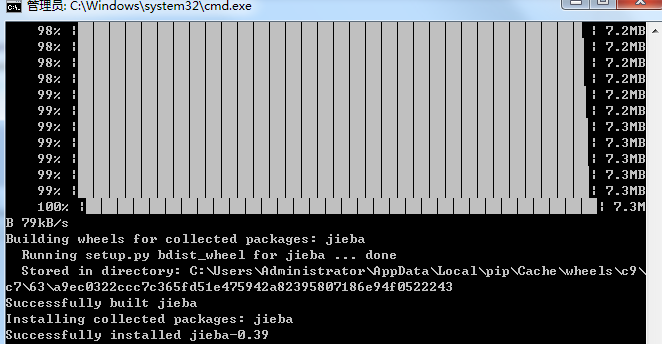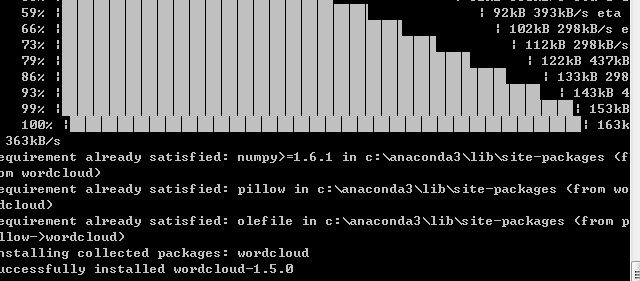本次作业的要求来自于:https://edu.cnblogs.com/campus/gzcc/GZCC-16SE1/homework/2822
一、中文词频统计
1. 下载一长篇中文小说。
2. 从文件读取待分析文本。
3. 安装并使用jieba进行中文分词。
pip install jieba
import jieba
jieba.lcut(text)


4. 更新词库,加入所分析对象的专业词汇。
jieba.add_word('三国演义') #逐个添加
jieba.load_userdict(word_dict) #词库文本文件
参考词库下载地址:https://pinyin.sogou.com/dict/
转换代码:scel_to_text
# -*- coding: utf-8 -*- import struct import os # 拼音表偏移, startPy = 0x1540; # 汉语词组表偏移 startChinese = 0x2628; # 全局拼音表 GPy_Table = {} # 原始字节码转为字符串 def byte2str(data): pos = 0 str = '' while pos < len(data): c = chr(struct.unpack('H', bytes([data[pos], data[pos + 1]]))[0]) if c != chr(0): str += c pos += 2 return str # 获取拼音表 def getPyTable(data): data = data[4:] pos = 0 while pos < len(data): index = struct.unpack('H', bytes([data[pos],data[pos + 1]]))[0] pos += 2 lenPy = struct.unpack('H', bytes([data[pos], data[pos + 1]]))[0] pos += 2 py = byte2str(data[pos:pos + lenPy]) GPy_Table[index] = py pos += lenPy # 获取一个词组的拼音 def getWordPy(data): pos = 0 ret = '' while pos < len(data): index = struct.unpack('H', bytes([data[pos], data[pos + 1]]))[0] ret += GPy_Table[index] pos += 2 return ret # 读取中文表 def getChinese(data): GTable = [] pos = 0 while pos < len(data): # 同音词数量 same = struct.unpack('H', bytes([data[pos], data[pos + 1]]))[0] # 拼音索引表长度 pos += 2 py_table_len = struct.unpack('H', bytes([data[pos], data[pos + 1]]))[0] # 拼音索引表 pos += 2 py = getWordPy(data[pos: pos + py_table_len]) # 中文词组 pos += py_table_len for i in range(same): # 中文词组长度 c_len = struct.unpack('H', bytes([data[pos], data[pos + 1]]))[0] # 中文词组 pos += 2 word = byte2str(data[pos: pos + c_len]) # 扩展数据长度 pos += c_len ext_len = struct.unpack('H', bytes([data[pos], data[pos + 1]]))[0] # 词频 pos += 2 count = struct.unpack('H', bytes([data[pos], data[pos + 1]]))[0] # 保存 GTable.append((count, py, word)) # 到下个词的偏移位置 pos += ext_len return GTable def scel2txt(file_name): print('-' * 60) with open(file_name, 'rb') as f: data = f.read() print("词库名:", byte2str(data[0x130:0x338])) # .encode('GB18030') print("词库类型:", byte2str(data[0x338:0x540])) print("描述信息:", byte2str(data[0x540:0xd40])) print("词库示例:", byte2str(data[0xd40:startPy])) getPyTable(data[startPy:startChinese]) getChinese(data[startChinese:]) return getChinese(data[startChinese:]) if __name__ == '__main__': # scel所在文件夹路径 in_path = r"C:sanguoyanyi" #修改为你的词库文件存放文件夹 # 输出词典所在文件夹路径 out_path = r"F:sanguoyanyi" # 转换之后文件存放文件夹 fin = [fname for fname in os.listdir(in_path) if fname[-5:] == ".scel"] for f in fin: try: for word in scel2txt(os.path.join(in_path, f)): file_path=(os.path.join(out_path, str(f).split('.')[0] + '.txt')) # 保存结果 with open(file_path,'a+',encoding='utf-8')as file: file.write(word[2] + ' ') os.remove(os.path.join(in_path, f)) except Exception as e: print(e) pass
5. 生成词频统计
6. 排序
7. 排除语法型词汇,代词、冠词、连词等停用词。
8. 输出词频最大TOP20,把结果存放到文件里
9. 生成词云。
txt = open('top_chinese20.csv','r',encoding='utf-8').read() wordlist = jieba.lcut(txt) wl_split = ''.join(wordlist) backgroud_Image = plt.imread('background.jpg') mymc = WordCloud(background_color='white',mask=backgroud_Image, margin=2,max_words=20,max_font_size=150,random_state=30).generate(wl_split) plt.imshow(mymc) plt.axis("off") plt.show() mymc.to_file(r'WordCloud.png')

